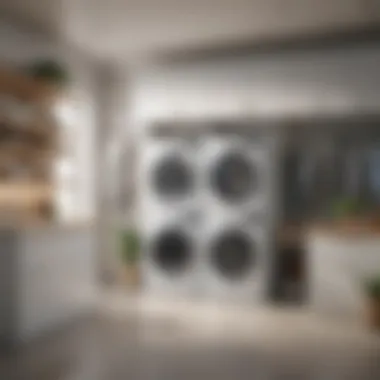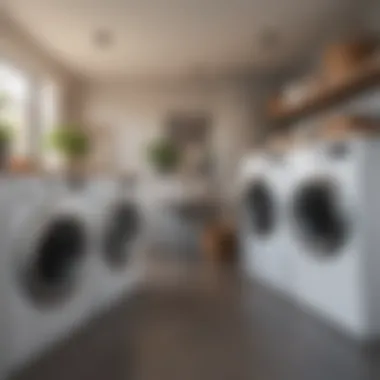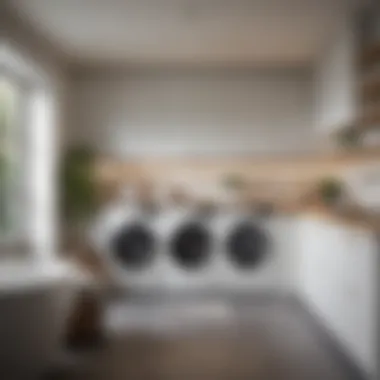Optimizing Your Laundry Room for Maximum Efficiency


Intro
Optimizing a laundry room layout is essential for functionality and efficiency. The design space serves more than just a practical purpose; it represents an intersection of utility and style. Homeowners benefit from an improved workflow, enhanced storage solutions, and an aesthetically pleasing environment. This article outlines critical components that make a laundry room a well-oiled machine, with detailed insights into design inspiration, common mistakes, and practical solutions.
Design Inspiration
Design inspiration for laundry rooms is pivotal in creating a space that merges utility wit visual appeal. Homeowners and enthusiasts should consider both current trends in interior design and practical color palettes to elevate the overall function of the room.
Current Trends in Interior Design
Today’s laundry rooms reflect broader interior design trends that prioritize minimalism and multi-functionality. Open shelving is gaining popularity for its accessibility and ability to display decorative yet functional items. This approach contrasts with traditional closed cabinetry, providing both practical storage and visual appeal.
Another trend is utilizing natural light to enhance the space. Large windows or skylights can create an inviting atmosphere that encourages a more enjoyable laundry experience. Additionally, integrating energy-efficient appliances not only supports sustainability but also contributes positively to the room's aesthetic.
Color Schemes and Palette Ideas
When selecting color schemes, consider soft neutrals paired with bold accent colors. Light grays or whites can create an airy feel, while colors like deep blues or rich greens can add character. Here, cohesion with surrounding spaces is crucial. A well-chosen palette can foster a sense of continuity throughout the home.
"A well-designed laundry room can elevate mundane chores into a more pleasant experience."
Workflow Optimization
The layout should enhance the user experience. Arranging appliances in a triangular sequence can support efficiency. For instance, placing the washing machine, dryer, and folding area in close proximity streamlines the process. It minimizes unnecessary movements and frustration, ensuring that each step is logical and smooth.
Storage Solutions
Effective storage is a hallmark of a well-planned laundry room. Consider using the vertical space by installing shelving units that reach the ceiling. This approach maximizes storage without occupying precious floor space. Additionally, implementing baskets for organizing supplies can make everything more accessible and visually organized.
Common Mistakes to Avoid
Many homeowners fall into the trap of neglecting the functional aspect of laundry room design. A common oversight is underestimating the importance of durability in materials. Choosing materials that can withstand moisture and wear is critical. Furthermore, failing to incorporate adequate lighting can make even the most beautiful laundry room feel uninviting.
Designing an effective laundry space draws on modern trends while ensuring every element serves a purpose. By being mindful of layout, storage, and color choices, you can transform a laundry room into a space that is not only functional but also enjoyable to use.
Preface to Laundry Room Layout
The laundry room is often an overlooked space in many homes. However, its layout has a direct impact on the efficiency of laundry tasks. When designed thoughtfully, a laundry room can streamline workflows, reduce time spent on chores, and enhance usability. The importance of optimizing this area cannot be underestimated.
The ideal layout should facilitate a seamless flow, allowing users to move easily from sorting clothes to washing and finally to drying or folding them. This article will cover various elements that contribute to an effective laundry room layout, emphasizing functionality and efficiency. Considerations include space utilization, placement of essential appliances, and design principles that make everyday tasks simpler.
By understanding the optimal design of a laundry room, homeowners can transform it into a practical space that meets their needs. Whether you are upgrading your existing layout or designing from scratch, a well-planned laundry room is essential.
Understanding the Purpose of a Laundry Room
A laundry room serves more than just the basic function of washing clothes. It is a place where household management is carried out. From cleaning and sorting to ironing and storing linen, every aspect of laundry care happens here. Properly defining the purpose of this space is crucial because it directly informs the layout and design choices.
When the purpose is clear, it helps in determining the necessary appliances to include. For instance, some households may require larger machines and dedicated spaces for folding, while others may only need the basics. Understanding how the laundry room fits within the broader context of home life can significantly influence how it is optimized. It is also essential to account for the activities that take place, such as removing stains or preparing garments for storage. This insight will ultimately improve the organization and workflow.
The Evolution of Laundry Room Designs
Historically, laundry rooms were simple spaces, often located in basements or outbuildings, with minimal attention to their layout. However, with the shift in household dynamics, these spaces have transformed. The evolution of laundry room designs reflects broader changes in domestic life and technology.
In the early 20th century, laundry was a labor-intensive task. Washboards and hand-operated washers dominated the scene. The mid century saw the introduction of electric washing machines, which necessitated more functional spaces dedicated to this task. Today's laundry rooms are often designed with aesthetics in mind, integrating modern technology and multifunctional tools.
Current trends emphasize practicality and style. Many homeowners are opting to enhance the visual appeal of their laundry rooms while still maintaining optimal functionality. Smart appliances, energy-efficient solutions, and environmentally sustainable materials are now integral parts of modern laundries. Understanding this evolution helps in making informed choices for current designs and layouts.
Key Considerations in Layout Planning
When designing a laundry room layout, several key considerations play a crucial role in achieving functionality and efficiency. These elements ensure that the space works to its full potential. From optimizing workflows to ensuring that appliances are placed correctly, careful planning can significantly enhance the user experience.
Space Measurement and Limitations
Accurate space measurement is fundamental. Knowing the dimensions of the laundry room allows for better planning of furniture and appliances. Measure walls, doorways, and windows, and account for ceiling heights. This information guides selections on equipment and fixtures. A room’s size may dictate a layout choice; for small spaces, compact appliances may be necessary.
Common limitations might include:
- Lack of electrical outlets
- Insufficient plumbing
- Limited square footage
Overcoming these challenges often requires creative problem solving. For instance, consider stacking washer and dryer units. This saves floor space while still providing necessary functionality. Additionally, think about clearances. Bumping into doors or getting stuck behind appliances can become frustrating quickly.
Essential Appliances and Their Placement
The cornerstone of any laundry room design lies in the placement of essential appliances. A washing machine and dryer are the primary devices to consider. Position these units to allow efficient movement between tasks, from washing to drying and folding. Ideally, the machines should be easily accessible from the entry point of the room.
Here are things to consider for appliance placement:
- Access to Plumbing: Ensure that washing machines are near existing plumbing to avoid complex installations.
- Ventilation for Dryers: Place dryers near an exterior wall for venting options to reduce moisture problems in the room.
- Proximity to Storage: Locate laundry baskets and detergent nearby, minimizing back-and-forth movement during laundry tasks.
Plumbing Provisions and Electrical Needs
The significance of plumbing and electrical arrangements cannot be overstated. Ensure that the necessary plumbing for washing machines is properly installed. It's advisable and often required to consult with professionals for such installations to avoid costly mistakes.
Electrical needs are equally important. Consider:
- Outlet Placement: Adequate outlets near machines should be included to power appliances.
- GFCI Protection: Ground Fault Circuit Interrupter outlets can protect against electrical shocks in wet areas.
- Lighting Requirements: Ensure that sufficient lighting illuminates work areas for added safety and convenience.


These foundational considerations establish a solid basis for efficient laundry room design. A well-laid-out laundry area can ultimately make chores simpler, quick and less of a burden.
Design Principles for an Effective Layout
The design principles of a laundry room layout are essential in ensuring maximum efficiency and functionality. A well-thought-out layout not only helps streamline daily tasks but also enhances the overall experience of using the space. This is particularly important considering that the laundry room can often become a cluttered area if not designed properly. Careful planning at this stage means less frustration and more productivity later.
Key considerations for an effective layout include workflow, storage, and ventilation. When these factors are addressed, the laundry room transforms from a mere utility space into a model of efficiency.
Creating a Functional Workflow
To create a functional workflow, it is vital to analyze the tasks typically performed in the laundry room. Common activities include washing, drying, folding, and ironing clothes.
- Establish Zones: Divide the space into specific zones for washing, drying, and folding. This helps keep things organized and efficient.
- Direct Pathways: Ensure direct and unobstructed paths between machines. Avoid placing obstacles that can hinder movement.
- Task Sequence: Arrange appliances in a sequence that follows your process. For example, position the washer near the dryer and then have a folding area nearby. This reduces time spent moving between tasks.
A well-planned workflow protects against clutter and maintains order, which is particularly advantageous for busy households.
Utilizing Vertical Space for Storage
In many cases, laundry rooms have limited floor space, making vertical storage an innovative solution. Here are some effective strategies:
- Wall-Mounted Shelves: Use wall-mounted shelves to store detergents and other supplies. This maximizes vertical space and keeps items within easy reach.
- Cabinetry: Install cabinets above appliances to house less frequently used items, such as seasonal laundry products or cleaning supplies.
- Hooks and Racks: Utilize hooks for hanging air-dry items or frequently used accessories, such as laundry bags and ironing boards.
By tapping into vertical storage, you not only conserve valuable floor space but also maintain a tidy environment.
Incorporating Natural Light and Ventilation
Effective use of natural light and ventilation can dramatically improve the laundry room environment. Proper lighting and airflow contribute to a more enjoyable and efficient workspace. Here's how to achieve that:
- Windows: If possible, include windows to allow for daylight. Natural light reduces the reliance on artificial lighting and creates a more pleasant ambiance.
- Skylights: In compact or windowless setups, skylights can be a suitable alternative. They provide both light and exposure to fresh air.
- Ventilation: Ensure adequate ventilation to eliminate humidity and odors, particularly from drying clothes. Exhaust fans or vents can facilitate air circulation, enhancing comfort.
“Design is not just what it looks like and feels like. Design is how it works.” - Steve Jobs
By adhering to these design principles, homeowners can cultivate a laundry room that not only meets their utility needs but also aligns with their aesthetic values.
Storage Solutions in Laundry Room Design
In any laundry room, effective storage solutions play a fundamental role. Properly designed storage options can significantly enhance the room's functionality, allowing homeowners to create an organized and efficient space. By considering various aspects of storage, from cabinetry to hampers, you can transform your laundry experience.
Cabinetry Options and Innovations
Cabinetry is a cornerstone in laundry room design. Selecting the right cabinets can maximize storage without consuming too much floor space. Custom cabinetry allows for personalized dimensions, which is especially crucial in smaller areas. Homeowners should consider options like built-in cabinets that align with the washer and dryer, providing a seamless look and added utility. Choose materials that are water-resistant and easy to clean to prolong the life of the cabinets in a space that often handles damp items.
Innovations such as modular cabinets can adapt to changing storage needs. Sliding or bi-fold doors are useful in tight spaces, allowing easy access without hindering movement in the room. Incorporating cabinetry above the washer and dryer also utilizes vertical space effectively, keeping cleaning supplies and detergents out of reach of children while ensuring they are easily accessible for adults.
Shelving and Organizational Tools
Well-placed shelves can significantly enhance utility in a laundry room. Open shelving provides easy visibility for items like detergents or baskets while promoting a sense of airiness in the design. When selecting shelving, opt for adjustable units that can grow with changing needs, allowing for taller bins as items increase or decrease.
Organizational tools, like labeled bins, can further promote efficiency. Consider using different containers for various supplies. For instance, you might designate one bin for fabric softeners and another for stain removers. This categorization simplifies the laundry process and saves time, preventing users from rummaging through unrelated items. Brackets or hooks can also be installed below shelves to hang frequently used tools, making laundry tasks more straightforward.
Hampers and Sorting Solutions
Proper sorting is essential for an efficient laundry process, and hampers are critical to this. Choosing the right hampers can facilitate an organized approach to laundry. Opt for multi-compartment hampers that allow for sorting clothes by color or fabric type before washing. This method removes the need to sort after gathering laundry, making laundry day feel less burdensome.
Portable hampers can offer flexibility, enabling easy transport to a washing machine or drying area. Look for lightweight materials with handles for effortless carrying. Additionally, consider placement—having hampers near the entry of the laundry room can encourage family members to deposit clothes promptly, maintaining a tidy space.
Effective storage solutions are vital in making laundry chores more manageable and functional. By investing in thoughtful design and innovative storage, you elevate your laundry room experience.
In summary, optimizing storage solutions in the laundry room involves careful selection of cabinetry, appropriate shelving, and efficient hampers. Each element contributes to a layout that minimizes clutter and enhances workflow, ensuring that this often-overlooked space serves its purpose to its fullest.
Common Layout Configurations
Understanding common layout configurations is crucial for designing an efficient laundry room. A well-planned layout allows for optimal workflow, maximizes available space, and enhances usability. Each configuration has its strengths and weaknesses, depending on the dimensions of the room and the specific needs of the user. The right choice can significantly improve both functionality and the overall experience in the laundry space.
Single-Row Layout
The single-row layout is a straightforward option that suits narrower spaces. In this design, all appliances and work surfaces align along one wall.
This configuration can be beneficial in small homes or apartments where space is limited. It keeps everything within reach, which aids in efficiency. However, the drawback is that it can feel cramped, especially when multiple tasks are performed simultaneously. Adequate shelving or cabinets above can help maximize storage without cluttering the floor.
Consider the placement of the washer, dryer, and sink in a way that flow between these functional areas remains uninterrupted.
L-Shape Layout
The L-shape layout is versatile and can adapt to various room shapes. This configuration places appliances along two adjacent walls, creating a natural workflow triangle.
Benefits include:
- Increased counter space for folding, sorting, and ironing.
- Easier access to storage solutions as many cabinets and shelves can fit into the corners.
- Improved ventilation, as both sides can allow for natural airflow.
Though usually efficient, this layout requires more space than a single-row setup. Homeowners must ensure that the room is large enough to prevent a crowded feel.
U-Shape Layout
The U-shape layout offers an expansive workspace, with appliances and counters along three walls – forming a U.


This design excels in larger laundry rooms, providing an ergonomic working area.
Consider the following advantages:
- Ample counter space for sorting and folding while efficiently utilizing vertical storage.
- Better defined zones for washing, drying, and folding helps streamline processes.
- This layout fosters a pleasant working environment as movement flows easily without barriers.
However, it requires considerable space and can be inefficient if the room becomes overcrowded with furniture or excess appliances.
Galley Layout
The galley layout features parallel counters with appliances lined up on one or both sides of a narrow room. This layout works particularly well in compact spaces while still offering a practical workflow.
Key benefits include:
- Efficient use of space when other layouts don’t fit the design needs.
- Direct access to washing and drying facilities, enhancing task efficiency.
- Flexibility allows for additional features like utility sinks or shelves.
Challenges arise if the layout is too narrow. Care must be taken to ensure there is enough room for movement, which can affect overall efficiency.
Incorporating Multi-Functionality
Incorporating multi-functionality in a laundry room design is not just a modern trend but a necessity for many homeowners. This importance stems from the need to maximize limited space while enhancing the overall utility of the area. A well-thought-out multi-functional laundry room can serve various purposes, making it a versatile asset in your home. The benefits of such an approach are significant; they include optimized workflows, increased storage capacity, and the ability to adapt the space for different household tasks.
Key considerations in incorporating multi-functionality include:
- Assessing your lifestyle needs: Consider how often you utilize the laundry room and what additional functions it could serve.
- Designing for versatility: Each element within the space should be adjustable or capable of serving multiple purposes to accommodate changes in use over time.
- Selecting appropriate fixtures and appliances: Invest in multi-purpose appliances that not only wash but also dry and steam, which can save space and money in the long run.
Instead of simply being a utilitarian space, the laundry room can evolve into a multi-functional hub that supports various activities without compromising on efficiency or style.
Laundry Room as a Mudroom
Designating a section of the laundry room as a mudroom is a strategic choice for many households. This integration provides a convenient zone for transitioning between the outdoors and the home. With organized spaces for shoes, coats, and sports gear, it keeps the rest of the home clean and clutter-free. A mudroom-laundry room hybrid offers practical storage solutions.
Considerations for this layout include:
- Durable flooring materials: Select materials that can withstand moisture and dirt, such as tile or vinyl.
- Storage units: Use cabinetry or lockers that keep items stowed away, yet accessible.
- Hooks and Benches: Install hooks for coats and benches for ease of changing footwear, adding functional elements without overloading the space.
Doing so creates a seamless transition while maintaining the cleanliness of the home.
Integration with Home Office Spaces
In today’s work-from-home culture, integrating the laundry room with home office spaces can enhance usability. This allows for the optimization of both areas, especially in homes where space is at a premium. A laundry room that doubles as an office can maintain productivity while managing day-to-day chores.
When considering this integration, keep in mind:
- Adequate lighting: Ensure that both the laundry area and the workspace benefit from good natural light or well-placed artificial lighting.
- Soundproofing elements: If possible, include features that minimize noise from laundry appliances, making for a more conducive working environment.
- Organizational tools: Use smart storage solutions like rolling carts or dual-purpose shelving to keep office supplies and laundry essentials organized.
This design can yield a productive environment without sacrificing convenience.
Creating a Folding and Ironing Station
A dedicated folding and ironing station is a valuable addition to any laundry room, especially for those managing larger amounts of laundry or household tasks. Comfort and accessibility are critical when designing this component. The station aids in maintaining organization and efficiency, creating a streamlined workflow.
Key elements to consider include:
- Height-adjustable surfaces: Install countertops at the correct height for comfort to avoid strain while folding or ironing.
- Storage for supplies: Ensure easy access to laundry-related supplies such as detergents, fabric softeners, and ironing boards.
- Lighting: Illuminating the folding area is essential for visibility and precision, helping to avoid mistakes as you work through the laundry.
Incorporating a folding and ironing station not only improves efficiency but also transforms the laundry process from a chore into a less daunting task.
"Redesigning your laundry room for multi-functionality can vastly enhance both practicality and enjoyment in the household."
Design Trends in Laundry Rooms
In today's home design landscape, laundry rooms no longer exist as mere utilitarian spaces. Instead, they are evolving into functional areas that blend efficiency with aesthetic appeal. A well-designed laundry room can improve workflow, enhance the overall value of a property, and serve as a pleasant environment for completing household tasks. Understanding the latest trends in this domain can help homeowners make informed decisions that benefit both functionality and style.
Color Schemes and Finishes
The choice of colors and finishes can dramatically affect the mood and perception of a laundry room. Modern trends favor soft, neutral palettes like whites, greys, and beiges to create a clean and serene environment. These tones offer a sense of openness and make the room feel larger.
Adding accents through vibrant colors in accessories, such as baskets or towels, can infuse personality without overwhelming the space. The finishes selected also contribute to the room's vibe; matte finishes can impart a rustic feel, while glossy surfaces can suggest a more contemporary style.
Moreover, the durability of finishes is critical in a laundry room, as moisture and everyday use can wear down surfaces quickly. Choosing materials such as ceramic, stainless steel, or waterproof paint ensures longevity and ease in maintenance.
Sustainable Materials and Practices
A growing emphasis on sustainability is reshaping laundry room designs. Homeowners increasingly seek eco-friendly materials that reduce environmental impact. Bamboo cabinetry, reclaimed wood shelves, and recycled countertops are becoming more common.
Utilizing energy-efficient appliances also fits into this trend. Washers and dryers that use less water and energy contribute to lower utility bills and less resource depletion. It’s also beneficial to integrate water-saving fixtures to minimize waste.
Promoting smart practices like using cold water for washing or line-drying clothes can further enhance sustainability. These steps not only support the environment but often lead to a healthier household by eliminating harmful chemicals found in some plastic materials used in conventional laundry products.
Smart Appliances and Technology
The rapid advancement of technology has brought forth a range of smart appliances designed for laundry rooms. Devices equipped with Wi-Fi connectivity offer homeowners the ability to monitor and control their machines from a smartphone. This level of convenience streamlines the laundry process and allows for better time management.
For instance, sensors in modern washers can determine the optimal water level and cycle duration based on load size, which enhances efficiency. Moreover, many smart dryers now use moisture sensors to prevent over-drying, preserving fabric quality and reducing energy consumption.
Integrating these innovations into the laundry space also often involves thoughtful planning of electrical outlets and plumbing for proper device installation. This consideration allows homeowners to leverage technology while ensuring safety and compliance with building codes.


"Embracing modern design trends can transform a mundane laundry task into a streamlined, stylish experience."
Challenges in Laundry Room Optimization
When it comes to optimizing your laundry room layout, a few notable challenges require careful thought. These obstacles can significantly impact the functionality and efficiency of the space. Addressing these issues impacts how well the laundry room serves its purpose and also contributes to overall home improvement. By recognizing the challenges, homeowners can better strategize to create a laundry room that is not only practical but also enhances the home’s aesthetics.
These challenges can be divided into key areas, each presenting different considerations:
- Limited space availability
- Balancing functionality with visual appeal
Identifying these challenges is crucial in tailoring an effective layout that meets the needs of both laundry processes and home aesthetics.
Limited Space Constraints
Limited space is often the most pressing issue in laundry room design. Many homes feature laundry rooms that are small or awkwardly shaped. This necessitates creative solutions to maximize every inch of the area.
Consider your appliance size. Full-size washers and dryers are common, but compact models are available. In a tight space, these can free up additional room for storage or workspace. When planning the layout, it is important to measure floor dimensions accurately, including door swings and the flow of foot traffic.
Tips for dealing with limited space:
- Stacked Models: Installing a stackable washer and dryer can save floor space.
- Foldable Surfaces: Use folding tables that can be expanded only when needed.
- Wall-mounted Shelves: These provide storage without taking up essential floor space.
Practically addressing the limitations of your laundry room leads to increased functionality. Moreover, this approach makes the space feel less cramped. A well-planned room can mirror spacious, inviting atmospheres found in larger laundry areas.
Balancing Accessibility and Aesthetics
Achieving a balance between accessibility and aesthetics in the laundry room can be tricky. On one side, you want a visually appealing room that aligns with your home's overall style. On the other, practicality should never take a backseat.
When developing a layout, consider both the placement of appliances and the way the design elements work together. For instance, choose cabinetry that provides storage while matching your home’s decor. Explore options such as hidden storage solutions to keep the space tidy. This can make significant visual enhancements, often vital in areas like a laundry room where functionality is paramount.
Suggestions for balance:
- Color Coordination: Select colors that blend well with adjacent rooms, creating a cohesive look.
- Functional Décor: Use items that serve dual purposes, like decorative hampers.
- Strategic Lighting: Ensure the space is well-lit for both visibility and visual warmth, utilizing fixtures that compliment the overall design.
Ultimately, balancing these two factors ensures the laundry room does not become a neglected function of the home but rather a part of the aesthetic and functional harmony. Striving for excellence in this area not only improves convenience but also elevates the home’s ambiance.
Mistakes to Avoid in Laundry Room Design
Designing a laundry room involves thoughtful consideration of various elements to ensure that the space serves its purpose efficiently. However, there are common mistakes that can hinder functionality and lead to frustration. Understanding these errors is crucial for homeowners and design enthusiasts alike. Avoiding these pitfalls will not only enhance the utility of the space but also contribute to a more enjoyable experience.
Ignoring Workflow Processes
One of the most significant mistakes in laundry room design is neglecting the workflow processes. The laundry workflow generally involves several steps: sorting, washing, drying, folding, and sometimes ironing. If the layout does not support a smooth transition through these tasks, it can create unnecessary inefficiencies.
To optimize workflow, consider how often items need to be sorted and how far they must be carried before washing. The distance between the washer, dryer, and folding area is essential. Ideally, the design should allow for easy movement from one station to the next.
It can be beneficial to create zones within the laundry room. For instance, keep hampers near the entrance for easy sorting, while the washer and dryer should be centrally located. This arrangement minimizes movement and time spent navigating the space.
Overlooking Lighting Needs
Lighting is another critical aspect often overlooked in laundry room design. Poor lighting can make tasks challenging and can even lead to mistakes, such as overlooking a stain or misplacing an item. A well-lit space enhances functionality and safety.
Incorporating natural light should be a priority. Windows can brighten the space during the day, providing a more pleasant environment. However, as many laundry rooms are situated away from adequate sunlight, artificial lighting must be carefully considered. Pendant lights or recessed ceiling lights that illuminate countertops can make a significant difference.
Additionally, consider installing task lighting near the washer and dryer, as well as in areas designated for folding or ironing. A well-lit laundry room not only improves productivity but also helps ensure that the area remains clutter-free and welcoming.
Neglecting Ventilation and Odor Control
Ventilation is essential in any laundry room, but it is often neglected. A lack of proper air circulation can lead to musty odors, mold, and mildew, particularly in spaces that are damp from washing clothes. Moreover, improper ventilation can adversely impact the longevity of appliances as well.
To maintain good air quality, ensure that the laundry room has adequate ventilation. This can be achieved through windows, vents, or even exhaust fans that can help expel moist air.
Using dehumidifiers can also be beneficial, especially in more humid climates. Additionally, integrating odor control solutions, such as charcoal bags, can help keep the space smelling fresh. By addressing ventilation and odors, homeowners can create a pleasant working environment.
In summary, avoiding common mistakes in laundry room design, such as neglecting workflow, underestimating lighting needs, and overlooking ventilation, will enhance the overall efficiency of this vital space. Small adjustments can lead to significant improvements.
Finale and Final Thoughts
In the realm of laundry room design, optimizing layout for functionality and efficiency emerges as a pivotal theme. This article has delved into the key components that contribute to an effective laundry space, focusing not only on aesthetics but also on practical use. Understanding the importance of a well-thought-out layout can significantly transform the mundane task of laundry into a more manageable and pleasant experience.
An efficient laundry room should enhance workflow, making the process smoother. Elements such as appliance placement, workflow patterns, and storage solutions are foundational to achieving this goal. When homeowners prioritize these aspects, they can enjoy a space that not only accommodates washing and drying but also offers room for organization and planning. More so, shifting to newer trends like multi-functionality and sustainable materials enriches the overall utility of laundry rooms and aligns them with modern household needs.
The aspect of avoiding common pitfalls is equally critical. The insights into mistakes to avoid have proven essential for those looking to create a space that serves their specific needs without being overwhelmed by clutter or design flaws. This guidance informs readers about actionable steps they can implement to improve their laundry experience.
Ultimately, as the demands on home spaces evolve, so too must the designs within them. The focus on functionality and efficiency will only continue to grow in significance. Those investing time in understanding and implementing the principles outlined in this article are likely to see considerable benefits in both daily routines and overall home atmosphere while navigating laundry tasks with enhanced ease.
Summarizing Best Practices
To ensure an effective laundry room layout, consider the following best practices:
- Assess the space: Begin with accurate measurements of your laundry area to understand its limitations.
- Prioritize workflow: Design the space with a logical flow from sorting to washing, drying, and folding.
- Strategic appliance placement: Position appliances like washers and dryers for easy access while maintaining functionality.
- Maximize storage: Use shelves, cabinets, and hampers efficiently to keep the area organized and tidy.
- Focus on lighting: Ensure ample task lighting while considering natural light sources to improve comfort.
By integrating these practices, anyone can optimize their laundry experience.
Future Directions in Laundry Room Design
Looking ahead, the future of laundry room design is likely to involve:
- Technology integration: Smart appliances, such as those offered by Samsung or LG, will enhance efficiency with features like remote control and cycle optimization.
- Sustainable solutions: An increase in eco-friendly products and designs will likely be prominent as society becomes more environmentally aware.
- Versatile spaces: The trend of multifunctional rooms will continue, with laundry areas also serving as mudrooms or additional workspace.
Embracing these future trends is essential for staying current in home design, and they can lead to a laundry room that is not only functional but also aligned with modern values and lifestyles.
"A well-designed laundry room can significantly elevate the efficiency of your home routines and create a backdrop for necessary chores that feels inviting rather than a burden."



